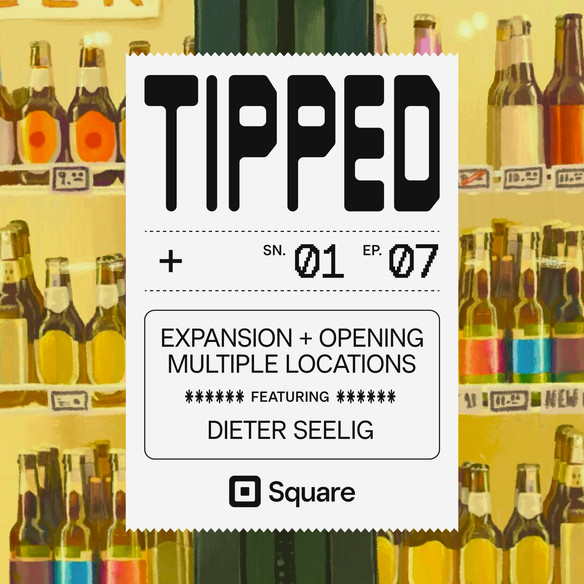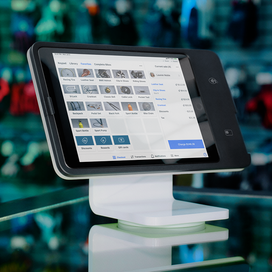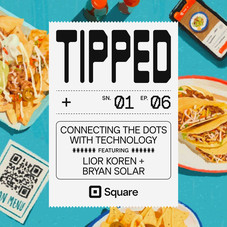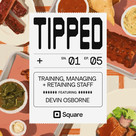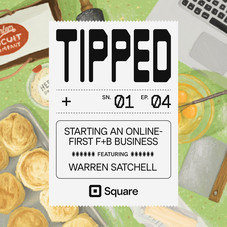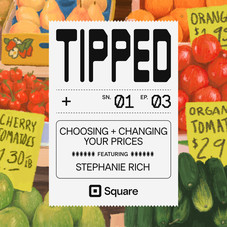Table of contents
For many owners in the food and beverage industry, growth is the goal. And often that means the opportunity to expand is a welcomed one. From one location to two, from one concept to another, from a brick-and-mortar to an online store or the reverse, there is no one-size-fits-all approach when it comes to expanding a business. Dieter Seelig of Craft + Carry, a multi-location craft beer alehouse in New York City, knows exactly what it takes to do expansion the right way and knows that ultimately, it has to be a carefully considered and executed move for the business overall.
“The decision of whether or not to expand is a really personal decision in the sense there has to be a lot of parts in alignment to make that happen.”
If you’ve found success since opening your business, have had a few years of steady success, and have customers starting to ask when a location is coming to a neighborhood or city near them, it might be time to start exploring expansion into another location. Seelig shares his best tips on how to approach expansion below.
3 tips for expanding your F&B business from Dieter Seelig of Craft + Carry
- Expansion means more than new locations: “It’s the new channels that we’re looking to get into, whether it’s really bolstering our online delivery or really bolstering our direct business. One of the things that Craft + Carry does is we have our certified staff which we can then send out to office buildings, co-op boards, etc, to host events. All these people are looking for craft beer events. They’re looking for people to come and explain what’s going on in the craft beer world and so we’ve been having more and more of these events and these are just new growth channels for us.”
- Find the fit between your brand and the neighborhood of each location: “The familiarity of the brand, there has to be a throughline with our businesses. There’s always gonna be some differences just by the virtue of the spaces themselves, but the overall feel, we try to keep similar. We want people to know what they’re getting when they’re walking in, but we also understand that when we’re on St. Mark’s Place, we have to be a fun place on St Mark’s. And when we’re in a quieter residential neighborhood, in terms of the music, maybe in terms of the chalkboards and the way we get people’s attention, we’re gonna have to tailor some of that to the, to the location specifically.”
- Have a marketing strategy for each new location: “When we’re opening a new Craft + Carry, we use Square Marketing and that’s a great way to get in touch with 15,000 of our customers real quickly. We see a good return on that. We also do press releases. Interestingly enough, those seem to actually get reported on, especially within the industry. Maybe we have something else going along with it, sort of put together more of an opening event. I think it takes about a year for our locations to really feel lived-in and start becoming part of the neighborhood. But we can see within the first two, three weeks, just such a turnout of people knowing, oh, wow, you guys are opening up here. We love you from this other location.”
Listen to more episodes of Tipped.
Full Transcript
Hi, and welcome to Tipped, a Square podcast. Expanding your business comes with many challenges and moving parts. From one location to two, from one concept to another, from a Brick and Mortar to an online store or the reverse there’s no one size fits all approach when it comes to expanding a business.
Dieter Seelig: Growth, for sure is not just number of locations, but it’s also obviously sales totals interactions with customers. Also, how many followers we have on Instagram, how many people are liking a post that we make? These are all different ways that we can define growth.
That’s Dieter owner of Craft+Carry a New York based bottle. Shop taproom and craft beer curator. Craft+Carry first opened its stores in downtown Brooklyn in 2018, and has grown steadily since. Serving customers in both Brooklyn and Manhattan via its six different locations. We asked Dieter what the biggest indicators of growth his team usually look for and how to steadily account for growth while simultaneously staying competitive in a crowded market.
Dieter Seelig: Just having a business in New York city, there’re tons of competition, there’re tons of costs. People would always ask me why we’re opening more locations or why aren’t you happy with one or two or three or whatever it was. And the reality is, the city and just life is always chiseling away at your business. I hate to say you’re always one corner from disaster and the idea of growth is also a way to survive frankly, in New York city. So when I see that a business isn’t only supporting itself doing well, but that we’re actually already hearing from customers. That’s usually when we know it’s time to grow. When we’re having numbers of customers who travel to one location going, why don’t you have a crafting carry on the upper east side? Why don’t you have a crafting carry on the upper west side or down in Hills kitchen?
And that usually is what starts a lot of these space and location hunts that we do when we’re looking for new locations. Having a new location open is super exciting, but being able to see how our loyalty membership continues to increase, five, six, seven, 800 a month, new loyalty members, that’s growth for us. So it’s not just about the number of stores or locations, it’s about seeing each location fulfill its goal in terms of more sales, more interactions, quality experiences for the customers. This is all part of growth for us. When we’re hearing feedback from customers saying, we love what you’re doing, and maybe this is something we’ve only done in one location or two locations, or might have been when we first rolled out the loyalty membership, or it might have been whatever this one location might have done differently.
When we hear feedback that this is a great idea, or hey, you built a larger space. There’s more room for people. There’s more seating. When we realize that this is something that can be applied to a new location, maybe in a neighborhood that is being underserved, that’s going to be that feedback we need to make that next move.
If you are a business owner considering opening a new location, it’s always a good idea to scout neighborhoods yourself and develop key relationships with brokers within your city.
Dieter Seelig: Here in New York city, it’s always location, location, location. Basically, when we start to look at a neighborhood, we have brokers that we’ve worked with, but also during the pandemic, I was on my bike pretty much every day, biking around the city, looking at empty storefronts, looking at neighborhoods that could be a good fit for Craft+Carry. So a lot of it is just literally pounding the pavement, finding those deals before someone else does. But basically we would talk to our brokers, say, hey, we’re looking for a space in this general vicinity. This is a great strip. This is a great area, what’s available? And now we might be bringing to them some opportunities. So once we locate a space, then it’s a matter of getting a letter of intent to the landlord, the negotiation that goes with that, because we’re an alcohol serving establishment.
We also have to worry about getting a liquor license. So there’re all sorts of things that come into play with that. Whether or not the space had been
previously licensed for that matter, or if there’s legal code about how close they can be to schools or churches. So there’re all sorts of things that go into play before we find a location that works for us. But once we do, it’s a negotiation with the landlord, it goes through the community board for approval. I tend to be a little bit more of the foot on the gas pedal type owner I think when it comes to expansion because there’re opportunities, we know we’re doing something that’s a little different and we think we do it better than others. So we want to bring it to as many people as possible.
However, it’s important to consider that with more locations’ comes more
management responsibilities.
Dieter Seelig: We approach management as we know we can’t be in every place at once. There are the only way this business is possible right now. So for us, we’re looking for pretty much just management that cares about what they’re doing that aren’t just floating through the process and that same, whether it’s the work ethic or just the responsibility, it rubs off on new staff, for sure. And they see that this isn’t just a fly by night operation where we are trying to pretty much all of our management comes from employees that have worked their way up.
Dieter says that while not all locations should be identical, customers should still be able to recognize your brand throughout.
Dieter Seelig: There has to be a through line with our businesses, the intent for the customer. We do want a customer to be able to come in and say, oh, this is a Craft+Carry. I know what to expect. Wow, this is a larger Craft+Carry, oh, this is a Craft+Carry with more draft beers or more, maybe more coolers or this one has an outdoor space, or this one has a backyard. There’s always going to be some differences just by the virtue of the spaces themselves. But the overall feel, we try to keep similar. We want people to know what they’re getting when they’re walking in, but we also understand that when we’re on St Mark’s place, we have to be a fun place on St Mark’s. And when we’re in a quieter residential neighborhood, we can’t be that same maybe in terms of the music, maybe in terms of the chalkboards and the way we get people’s attention, we’re going to have to tailor some of that to the location specifically.
However, while one location may see success, business owners should be
prepared for the possibility that the other may not perform as well.
Dieter Seelig: That’s one of the things you learn from doing multiple locations is what we thought a Craft+Carry was in 2018 is vastly different from what we think a Craft+Carry is in 2022. And a lot of that had to come from seeing that, wow, we really needed to found a larger space, or we’ve seen that sales really just scale with the size of the space. So have we had situations where it’s underperformed because we realize there’s just not enough room for customers, there’s too much product. There has been slow, not to mention the pandemic didn’t help. We had three open stores going into the pandemic, and now we have eight. So we did a lot of expansion during the pandemic. That was very slow going, because as excited as you can be about a store opening, with the pandemic in 2020, basically killing everything in the city for a good six, eight months, we had to deal with having stores that weren’t performing as well as they should.
And it’s not fun. The rent has to be paid. The staff has to be paid. The
electricity has to be paid. And if the numbers aren’t there, it can get really depressing and you have to learn how to deal with those setbacks. And we’ve actually been able to keep every store open. We haven’t closed a Craft+Carry, which is great and they’re all surviving and better and doing quite well actually. It usually takes about a year for a location to really feel lived in and customers know that we exist. So for us, it’s part of this whole process and we treat every store as its own. So you really don’t want to be supporting an underperforming location with one that is doing well. I think if we were faced with a situation where a store was vastly underperforming, you hate to have to cut bait, but every now and then that is the reality.
Dieter says that when developing a marketing strategy, something as old
school as developing a press release can be useful when getting the word out
about a new business or business location.
Dieter Seelig: When we’re opening a new Craft+Carry some of the success that we’ve had, actually we use square marketing for a number of the openings where that’s a great way to get in touch with 15,000 of our customers really quickly. So we see a good return on that. We also do press releases, interestingly enough, those seem to actually get reported by a number, especially within the industry. So if we’re opening a new Craft+Carry, we’ll put out a press release saying, hey, we’re opening this Craft+Carry in this location. Maybe we have something else going along with it. Maybe we’re doing a popup at the Empire state building. Maybe we’re doing a collaboration with a brewery. All these things can be put together to create more of an opening event.
We ask square business owners to send in their most pressing questions. Today’s question is, what is the best course of action for an independent beverage business to move from direct B2C to a B2B model, which from your experience, you have a bunch of independent brands within your businesses. So what advice would you have to someone from your point of view on how to effectively do that?
Dieter Seelig: At Craft+Carry, we work with, I think it’s now about 85 or 90 distributors breweries independently. We have far more than that, but the distributors often have 50 or a hundred brands under their portfolio. We have a beverage manager who is typically the first person to have out reach with whether new breweries are coming to New York, whether it’s a new brewery, that’s just establishing yourself or someone that’s just began to distribute to New York. That’s one of the strongest parts about Craft+Carry is the fact that we work with hundreds of breweries and that when you walk in, it is a little bit like a kid in a candy store, the relationship between us and them, it’s reciprocal, it’s a very symbiotic relationship where we are promoting their business, but they’re also by having it with us, they’re their having better access to customers.
When a brewery comes to us and they have a great plan, they have a great ability to bring us the product, that’s one of the biggest issues we have is pretty much breweries not being able to keep up with demand, not being able to deliver as often as they would like or coming out of the pandemic. A lot of them have also tried to go the other way, which is a lot of these breweries that would almost always go business to business. They found during the pandemic that for them, it was easier or more cost-effective to cut out the middle man and go directly to the customers, which is interesting for us because in some ways, some of these breweries are now our competitors while we actually sell their product. I think the pandemic flipped a lot of the industry on its head, but for a brewery coming to us or a distributor coming to us, we’re looking for reliability, we’re looking for someone that’s bringing something that differentiates itself from all the other brands out there.
And understand that they’re part of a chorus here that we’re only as strong as the brands that we’re putting in our coolers and putting in our on our taps. So them putting their best foot forward makes us want to work with them. I think six or seven collaborations now with breweries, them being excited and flexible to as we grow. And as our needs change, same as with them as their needs change. We try to work with them as much as possible.
Our second question asks, we’ve been thinking about opening a second location since we opened the first one, but there have been a couple of big roadblocks. It’s hard enough just managing the one shop and finding enough employees to serve. We can’t even imagine doubling the workload and being able to find and afford a full-time manager. How does that work? It takes a few years to pull a profit and even then there’s a lot of risk of product market fit. Is it even worth it to open a second one or just stick to what we know and do best with the one shop?
Dieter Seelig: I think the decision of whether or not to expand is a really personal decision. There has to be a lot of parts in alignment to make that happen. You need to have whether it’s staff, obviously the finances have to make sense. It’s going to take you three years to recoup your initial investment. Then that has to be factored into your expansion plans. If you can build a space quickly and inexpensively and have it start turning a profit quickly, I mean then open as fast as you can. That’s the benefit of having the successful business in the first place is that there’s the demand, there’s now the knowledge that you have as a business owner, you go, I can handle this. You might not be able to.
And I think it’s a really personal decision that every business owner has to make, because you’re always going to be giving up something when you have an expansion. You’re not going to be able to give it the same personal detail as you would want. And there’s a reason why there’s not a pizzeria owner that has 20 pizzerias in New York city. It’s too tough to manage. And someone’s strong suit may not be in delegation. Someone’s strong suit may not be in the coordination that’s involved and they may just be better at sticking around and making one shop the best it can be. But it really is a personal decision I think.
We asked Dieter to pass on the best tips he’s learned from his experience in the food and beverage industry.
Dieter Seelig: The best advice I can give a business owner is to remember everything. It is absolutely imperative to either write down, have a good organization when it comes to why you were busy that day, why you were busy last month. You’re not going to remember two years from now why this month or this week was the busiest week you ever had. You really have to remember when these issues for us having eight stores, knowing how to fix something is incredibly valuable because that might happen two or three times a month, it might happen once or twice a year, but keeping track of your business and knowing your business and living your business is vital. Because if you are not excited about it, and if you don’t know how everything works in it, then no one else will. And if you want to be a business owner, you want to have that ownership.
I started in the hospitality industry as a bouncer working security. And I’m a big guy. I’m 6’7. If I was a foot shorter, I wouldn’t be in the industry. And it was a matter of working my way from security to management, to ownership, and everything in between. There is a value in knowing how things operate, there’s a value in remembering how to fix these things when the problems come up. So my general best advice would be, remember everything, write it down if you have to. But knowing where you’ve been is the absolute easiest way to know maybe which path you want. You should be taking in the future.
Thank you to Dieter for his time and insights for our show today. Dieter is the owner and founder of Craft+Carry in Brooklyn and New York city. Find them at Craft+Carry, one word on Instagram or at Craft+Carry NYC on Facebook. Give them a follower or send them a direct message to learn more. If you want to hear more like this, make sure to subscribe Tipped on Apple Podcasts, Spotify, or your podcast app of choice. You’ve been listening to Tipped, a Square production. This episode was produced by Kaitlin Keefer and Clara Shannon. Our music was composed by Jordan Wallace with Sound Recording by Sarino media and D.R Baker. Thanks for listening.
![]()

